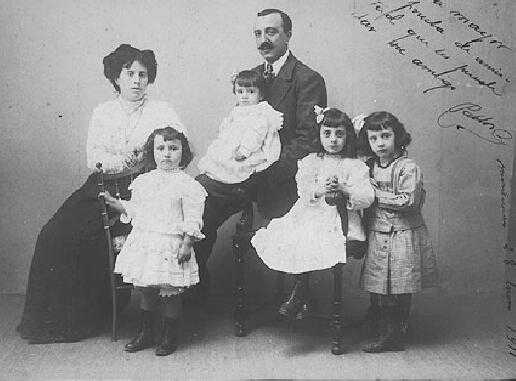
Palencla Family (Italy/Spain, about 1910s)

Figure 1.--This family was from Palencla, which may be in Italy or Spain. The portrait was taken about 1910. There look like four girls, bit we believe one is a boy. His name may be Luis Alonso which suggest this may be a Spanish family. A reader writes, The text isn't clear but seems well to be Spanish. One can read: "
Mayor.......que las...... dar un amigo. Meaning; The best.......give a friend." Perhaps other readers cam make out more.
|
|
Here we see an unidentified family. They are from Palencla. We are not sure where that is. We think it may be Italy, but Spain is another possibility. A HBC reader writes, "I think that the country concerned is Spain. I have looked in my atlas of Europe and cannot find anywhere named Palencla, but I have found two possible places in Spain. There is a Palancia (Note i and not l) Which is northeast of Valladolid. A second Palenciana which lies between Malaga and Cordoba. Of the two I would go for Palencla which, although not a very big place, is certainly a town of between 50,000 and 100,000 inhabitants, whereas, Palenciana is a very small village and is not on a main road." The portrait is also undated. We would guess the portrait was taken anout 1910. The father's suit looks very modern. The mother's outfit seems appropriate for about 1910 or perhaps a little earlier. There are four children. On first glance they all look to be girls, but we think one might be a boy. First, as their are four children, the chances are that at least one is a boy.They could be all girls, but the chances are that one may be a boy. Second, the child on the far right looks like a boy based on the plainness of the dress compared to the girl beside him. We have not noted girl's so close in age being dressed so differently, in a frilly and plain dress. Much more common is for them to be dressed in similar fancy dresses. Also unusual is having girls about the Third, the child at right also has the only colored dress. Now this might be because this child is the oldest, but combined with the plainess strongly suggest that this child is being set apart. The most likely explanation is because the child is a boy.
HBC

Navigate the Boys' Historical Clothing Italian pages:
[Main Itlalian page]
[Main Spanish page]
[Italian art]
[Italian catalogs]
[Italian choirs]
[Italian movies]
[Italian royalty]
[Italian school uniforms]
[Italian youth groups]
Navigate the Boys' Historical Clothing Web Site:
[Return to the Main Spanish family page]
[Introduction]
[Activities]
[Biographies]
[Chronology]
[Clothing styles]
[Countries]
[Girls]
[Bibliographies]
[Contributions]
[FAQs]
[Glossaries]
[Satellite sites]
[Tools]
[Boys' Clothing Home]
Created: 3:25 AM 10/22/2004
Last updated: 12:14 AM 10/5/2015



